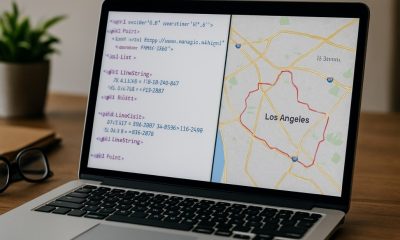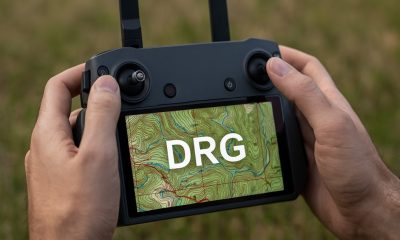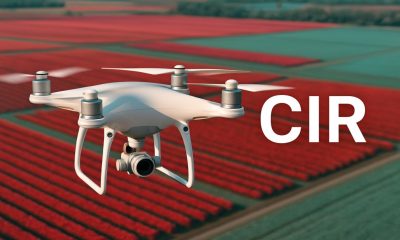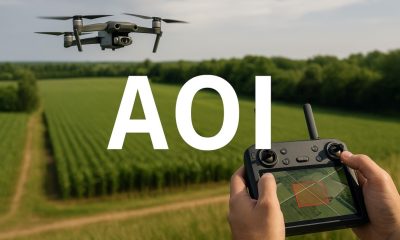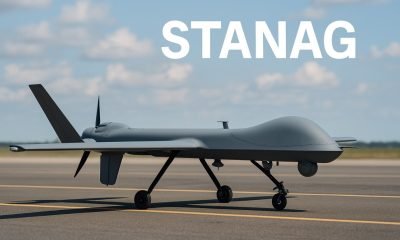- Acronym Guide
- AAM
- ABS
- AC
- ACAS
- ADS-B
- AFAC
- AGL
- AI
- AIM
- ALS
- AM
- AMA
- ANSP
- AOI
- APPI
- AUV
- AUVSI
- ARPAS-UK
- ASTM
- ATC
- BVLOS
- CAA
- CAAC
- CAB
- CASA
- CATT
- CBO
- CBR
- CBRN
- CDMA
- CDR
- CFR
- CIR
- COA
- COMINT
- CORS
- COTP
- COTR
- CPTED
- CV
- C2
- DAA
- DEM
- DFI
- DFS
- DGCA
- DHS
- DOD
- DPA
- DPEs
- DRG
- DRO
- DSM
- DSMX
- DSP
- DSSS
- DTM
- EASA
- EFT
- EO
- EOD
- EO/IR
- ELINT
- EMI
- ESC
- EVLOS
- eVTOLs
- FAA
- FCC
- FCS
- FHSS
- FICCI
- FLIR
- FOB
- FOV
- FPS
- FPV
- GBDAA
- GCP
- GCS
- GDPR
- GML
- GNSS
- GPS
- GSD
- GVC
- HDR
- HOGE
- IACRA
- ICAO
- ICS
- IMU
- INS
- IR
- ISA
- ISR
- ITU
- JARUS
- LAAMS
- LAANC
- LAATM
- LAI
- LBA
- LIDAR
- LOS
- LSALT
- MAC
- MAVLink
- MLIT
- MMS
- MSL
- MTOM
- NDAA
- NCSL
- NFZ
- NIST
- NMEA
- NOTAM
- NPA
- NPRM
- NTIA
- OBIA
- OEM
- OFDM
- OOP
- PASM
- PAV
- PCV
- PdM
- PEC
- PIC
- PID
- PIPL
- PLD
- PM
- PN
- PPK
- PPS
- PSM
- PWM
- UAM
- UAOP
- UAS
- UASTM
- UAV
- UCAVs
- UHD
- UHF
- USV
- UTM
- RAIM
- RCC
- RCS
- RFI
- ReOC
- RePL
- RMS
- ROI
- RPAS
- RPC
- RTH
- RTK
- SaR
- SAR
- SARP
- SBAS
- S.Bus
- SBIR
- SEDENA
- SfM
- SFOC
- SIGINT
- SLAM
- SMS
- SORA
- STANAG
- STTR
- sUAS
- TCAS
- TCCA
- TFR
- TIN
- TOF
- TP
- TPS
- TSA
- VHF
- VLOS
- VTOL
Drone Acronyms
What is DFS (Deutsche Flugsicherung)?
By
Jacob StonerTable Of Contents

Definition
DFS stands for Deutsche Flugsicherung, the German Air Navigation Service Provider (ANSP) responsible for managing air traffic control (ATC) in Germany. It operates under the supervision of the German government and is tasked with ensuring the safe and efficient movement of both manned and unmanned aircraft in German airspace. DFS manages all phases of flight, from takeoff and landing at airports to en-route air traffic.
Usage
DFS plays a critical role in maintaining the safety and efficiency of German air traffic. The agency manages air traffic control towers at airports, provides en-route air traffic services for aircraft flying through German airspace, and supports the safe integration of unmanned aerial vehicles (UAVs) like drones into national airspace. DFS ensures that both manned and unmanned flights are coordinated and monitored to prevent accidents and optimize flight operations.
Relevance to the Industry
DFS is essential for the aviation industry in Germany, providing real-time air traffic services and working closely with European aviation authorities, including Eurocontrol and the European Union Aviation Safety Agency (EASA). For drone operators, DFS is responsible for regulating airspace access, ensuring drones do not interfere with traditional aircraft operations, and implementing advanced systems like Unmanned Traffic Management (UTM) to integrate drones into low-altitude airspace.
How Does Deutsche Flugsicherung (DFS) Work?
Air Traffic Control Operations:
- Airspace Management:
- En-Route and Terminal Air Traffic Control: Deutsche Flugsicherung (DFS) manages air traffic across German airspace, from takeoff and landing at airports to the en-route phase of flights at cruising altitudes. DFS controls air traffic through a network of control centers that oversee different sections of the airspace. These centers provide real-time instructions to pilots to ensure safe distances between aircraft, manage flight paths, and avoid mid-air collisions.
- Coordination with Neighboring Countries: DFS collaborates closely with Eurocontrol, the European organization for the safety of air navigation, and neighboring air navigation service providers (ANSPs) to ensure that aircraft passing through German airspace can seamlessly transition between air traffic control zones. This international coordination is essential for managing cross-border flights and ensuring that aircraft operate safely as they move between different countries’ airspaces.
- Airport Control Towers:
- Tower Control Services: DFS operates control towers at major airports throughout Germany, where air traffic controllers direct all aircraft movements on the ground and during takeoff and landing. The tower controllers coordinate with ground crews, pilots, and airport authorities to manage the flow of aircraft in and out of airports, ensuring efficient operations and preventing accidents on the runway or taxiways.
- Communication and Navigation Systems: DFS uses advanced communication and radar systems to maintain continuous contact with aircraft in the air and on the ground. These systems provide real-time data on aircraft positions, weather conditions, and potential conflicts, allowing controllers to make informed decisions and issue timely instructions to pilots.
Drone Integration and Unmanned Traffic Management (UTM):
- Managing Drone Operations:
- Unmanned Traffic Management (UTM): DFS is responsible for developing and implementing UTM systems to integrate drones into low-altitude airspace safely. These systems help drone operators plan flights, avoid restricted areas, and ensure that drones do not interfere with manned aircraft operations. DFS provides real-time data to drone operators about weather conditions, airspace restrictions, and other critical information to help them navigate safely.
- Airspace Access and Permissions: DFS plays a central role in regulating drone operations by setting guidelines on where drones can fly, including no-fly zones near airports, over populated areas, or near critical infrastructure. For higher-risk drone flights, such as Beyond Visual Line of Sight (BVLOS) operations or flights near controlled airspace, DFS requires operators to obtain special permissions to ensure safety and coordination with manned aircraft.
Safety and Efficiency Measures:
- Real-Time Air Traffic Control Systems:
- Radar and Satellite-Based Navigation: DFS uses a combination of ground-based radar systems and satellite-based navigation systems to monitor and guide aircraft in German airspace. These systems allow controllers to track the precise location of aircraft, maintain safe separation between planes, and manage the flow of air traffic efficiently. Satellite-based systems like ADS-B (Automatic Dependent Surveillance-Broadcast) are increasingly used to improve accuracy and coverage, especially in remote areas.
- Flight Plan Management: Before every flight, airlines and pilots submit flight plans to DFS for approval. The flight plan includes details such as the aircraft’s route, altitude, and expected timing. DFS reviews these plans and ensures they do not conflict with other flights. Once the flight is approved, DFS monitors the aircraft throughout its journey and can make adjustments to the flight path if necessary, such as in response to weather changes or traffic congestion.
- Conflict Resolution and Safety Protocols:
- Air Traffic Conflict Detection: DFS controllers continuously monitor aircraft for potential conflicts, such as planes flying too close to each other or deviating from their assigned flight paths. In such cases, controllers issue instructions to adjust altitudes, change headings, or take other corrective actions to prevent dangerous situations. The system relies on automation and human expertise to quickly detect and resolve conflicts, minimizing risks to passengers and aircraft.
- Incident Reporting and Investigation: If an incident occurs, such as a near miss or an unauthorized drone entering restricted airspace, DFS investigates the event to determine the cause and recommend safety improvements. The organization works closely with the German Federal Bureau of Aircraft Accident Investigation (BFU) and other authorities to ensure aviation safety standards are continuously enhanced.
Collaborative Efforts and Future Technologies:
- Collaboration with European and International Partners:
- EU Air Traffic Integration: DFS is part of Europe’s Single European Sky initiative, which aims to harmonize air traffic control across the EU to reduce delays, improve fuel efficiency, and enhance safety. This collaboration helps streamline air traffic management across borders and improves the overall efficiency of the European airspace.
- Eurocontrol Cooperation: DFS works with Eurocontrol to manage the flow of flights over long distances and across multiple countries, ensuring that flights departing from or arriving in Germany operate smoothly in European airspace.
- Adopting Advanced Technologies:
- Automation and AI in Air Traffic Management: DFS is investing in automation technologies and artificial intelligence (AI) to enhance the efficiency of air traffic control. Automation tools help controllers manage more flights simultaneously by reducing their workload and improving decision-making processes.
- Urban Air Mobility (UAM): DFS is also preparing for the future of Urban Air Mobility, which includes the integration of air taxis and autonomous aerial vehicles into urban airspaces. DFS is working with industry partners and regulatory bodies to develop the infrastructure and regulations needed to safely manage these emerging technologies.
By overseeing air traffic control, managing drone integration, and implementing advanced air navigation systems, Deutsche Flugsicherung (DFS) plays a vital role in maintaining the safety and efficiency of Germany’s airspace for both manned and unmanned aircraft.
Example in Use
“Deutsche Flugsicherung (DFS) introduced new air traffic management protocols to ensure safe coordination between commercial flights and drone operations near airports.”
Frequently Asked Questions about DFS (Deutsche Flugsicherung)
1. What are the main responsibilities of DFS?
Answer: The main responsibilities of DFS include:
- Air Traffic Control (ATC): Providing air traffic control services at airports and en route for all flights within German airspace, ensuring safe and efficient navigation.
- Airspace Management: Managing German airspace by coordinating flight paths, providing real-time air traffic information, and ensuring that manned and unmanned aircraft can operate without conflicts.
- Drone Integration: Supporting the integration of UAVs (drones) into national airspace through the implementation of Unmanned Traffic Management (UTM) systems and airspace access rules for drone operators.
2. How does DFS regulate drones in German airspace?
Answer: DFS regulates drones by:
- Implementing UTM Systems: DFS is involved in creating Unmanned Traffic Management (UTM) systems that allow for the safe and efficient integration of drones into low-altitude airspace.
- Setting Airspace Restrictions: DFS sets rules for where drones can and cannot fly, such as around airports, in controlled airspace, and near critical infrastructure, to avoid conflicts with manned aircraft.
- Enabling Drone Flights: DFS collaborates with the Luftfahrt-Bundesamt (LBA) to grant permissions for commercial and high-risk drone flights, ensuring they meet safety standards.
3. How does DFS ensure air traffic safety?
Answer: DFS ensures air traffic safety by:
- Real-Time Air Traffic Control: Managing aircraft movements in real-time using radar, communication, and navigation systems to ensure planes maintain safe distances and avoid collisions.
- Coordination with European Authorities: Working with Eurocontrol and other European ANSPs to coordinate international flights and ensure smooth transitions between different airspaces.
- Advanced Technology: Employing the latest technology in air traffic management, such as satellite-based navigation and automated systems, to improve safety and efficiency.
For examples of these acronyms visit our Industries page.
As the CEO of Flyeye.io, Jacob Stoner spearheads the company's operations with his extensive expertise in the drone industry. He is a licensed commercial drone operator in Canada, where he frequently conducts drone inspections. Jacob is a highly respected figure within his local drone community, where he indulges his passion for videography during his leisure time. Above all, Jacob's keen interest lies in the potential societal impact of drone technology advancements.


